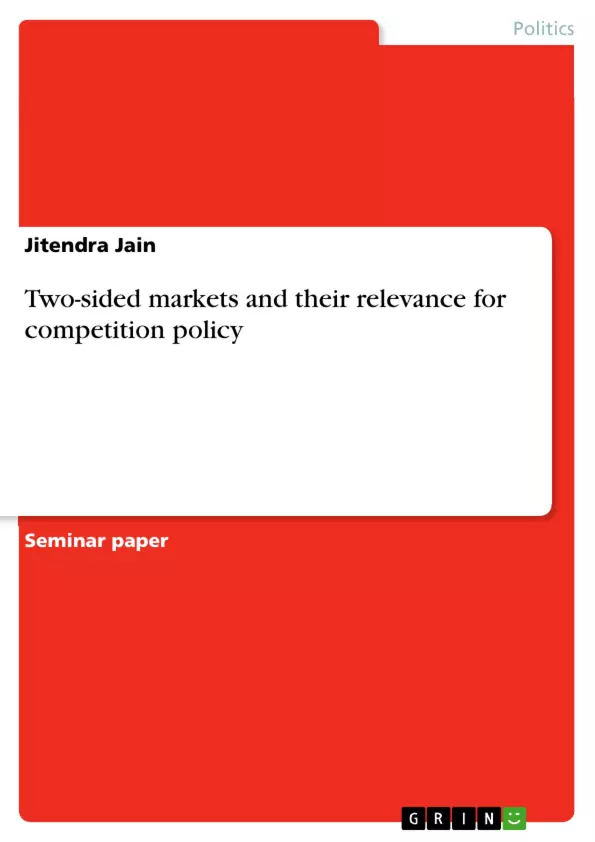Two-sided markets consist of two or more exclusive groups, present simultaneously on a single platform. They both need each other. In order to succeed the platform provider must ensure active participation of both groups. In the beginning these bazaars face chicken-and-egg problem, which should be solved, sometimes even by providing free chicken. These markets include some of the most important industries in new economy such as mobile telephony companies, free TV services, OS suppliers, software providers, gaming companies, credit card companies, auction sites etc. Ebay and amazon are good examples of two-sided markets. In such two-sided markets buyers and sellers first trade with the intermediary/ies so as to gain access to the functionalities of a platform and then trade with each other under oligopolistic conditions. In chapter 1 of this paper an attempt has been made to describe finer nuances of two-sided markets. Thereafter I proceed to discuss the various dynamics of two-sided markets in chapter 2. Two-sided firms differ from traditional industries and they follow totally different business economics. Marginal cost does not help them in deciding optimal price. Pricing policies and other business strategies must be formulated in such a way that it should ensure active interaction of both groups. Pricing strategy should get both sides on board and should also solve chicken-and-egg problem. Chapter 3 describes the pricing policy adopted by two-sided markets. Chapter 4 deals with relevance of two-sided markets for competition policy. Competition Authorities do not need different set of rules to regulate these industries. However Competition Authorities must consider various economic principles that influence pricing and investment decisions in two-sided markets. Chapter 5 concludes with various observations and suggestions.
Inhaltsverzeichnis (Table of Contents)
- Introduction
- An attempt to define two-sided markets
- Existence of two or more groups
- Getting and keeping critical mass
- Dynamics of two-sided markets
- Network effects
- The chicken-and-egg problem
- Multihoming
- Economic rationale behind two-sided markets
- Deciding optimal pricing structure
- MC irrelevant for profit maximization
- Relevance of two-sided markets for competition policy
- Market Definition - SSNIP test
- Market Power
- Barriers to Entry
- The Efficiency Factor
- Predation
- Other Issues
- Concluding Observations and Suggestions
Zielsetzung und Themenschwerpunkte (Objectives and Key Themes)
This paper examines the characteristics and dynamics of two-sided markets, exploring their relevance for competition policy. It aims to provide a comprehensive understanding of these markets, highlighting their unique economic features and how they differ from traditional industries.- Defining two-sided markets and their distinct features
- Analyzing the dynamics of network effects, the chicken-and-egg problem, and multihoming
- Exploring the economic rationale behind two-sided markets, particularly pricing strategies and profit maximization
- Examining the implications of two-sided markets for competition policy, including market definition, market power, and barriers to entry
- Addressing the efficiency factor, predation, and other relevant issues in the context of two-sided markets
Zusammenfassung der Kapitel (Chapter Summaries)
The paper begins by attempting to define two-sided markets, highlighting the need for a platform that enables interaction between two or more groups, each relying on the presence of the others. The definition emphasizes the importance of a third entity facilitating this interaction, illustrated by examples like free TV, pay TV, and online marketplaces. The second chapter delves into the dynamics of two-sided markets, exploring network effects, the chicken-and-egg problem, and multihoming. Network effects describe the increasing value of a platform as more users join, while the chicken-and-egg problem refers to the challenge of attracting enough users from both sides to create a viable market. Multihoming explores the possibility of users subscribing to multiple platforms, creating a dynamic where each platform seeks to attract and retain users. The third chapter examines the economic rationale behind two-sided markets, emphasizing that traditional marginal cost analysis is not relevant in this context. The need to attract and retain both sides of the market requires strategic pricing policies designed to incentivize user interaction. The fourth chapter delves into the relevance of two-sided markets for competition policy. While competition authorities do not need to develop new rules specifically for these markets, they must consider the unique economic factors that influence pricing and investment decisions. These include market definition, market power, barriers to entry, the efficiency factor, predation, and other relevant issues.Schlüsselwörter (Keywords)
Two-sided markets, network effects, chicken-and-egg problem, multihoming, pricing strategy, competition policy, market definition, market power, barriers to entry, efficiency factor, predation.- Citar trabajo
- Jitendra Jain (Autor), 2006, Two-sided markets and their relevance for competition policy, Múnich, GRIN Verlag, https://www.grin.com/document/126737



